Itō Hirobumi
Prince Itō Hirobumi (伊藤 博文, 16 October 1841 – 26 October 1909, born as Hayashi Risuke and also known as Hirofumi, Hakubun and briefly during his youth as Itō Shunsuke) was a Japanese politician, Prime Minister and preeminent member of Japan's genrō, an elite group of senior statesmen who dominated the Meiji oligarchy. A London-educated samurai of the Chōshū Domain and leader of the early Meiji Restoration government, he chaired the bureau which drafted the Meiji Constitution in the 1880s. Looking to the West for inspiration, Itō rejected the United States Constitution as too liberal and the Spanish Restoration as too despotic. He instead drew on British and German models, particularly the Prussian Constitution of 1850. Dissatisfied with Christianity's pervasiveness in European legal precedent, he replaced such religious references with those rooted in the more traditionally Japanese concept of a kokutai or "national polity" which hence became the constitutional justification for imperial authority.
Prince Itō Hirobumi | |||||||||||||||||||||||
|---|---|---|---|---|---|---|---|---|---|---|---|---|---|---|---|---|---|---|---|---|---|---|---|
伊藤 博文 | |||||||||||||||||||||||
 | |||||||||||||||||||||||
| President of the Privy Council of Japan | |||||||||||||||||||||||
| In office 14 June 1909 – 26 October 1909 | |||||||||||||||||||||||
| Monarch | Meiji | ||||||||||||||||||||||
| Preceded by | Yamagata Aritomo | ||||||||||||||||||||||
| Succeeded by | Yamagata Aritomo | ||||||||||||||||||||||
| In office 13 July 1903 – 21 December 1905 | |||||||||||||||||||||||
| Preceded by | Saionji Kinmochi | ||||||||||||||||||||||
| Succeeded by | Yamagata Aritomo | ||||||||||||||||||||||
| In office 1 June 1891 – 8 August 1892 | |||||||||||||||||||||||
| Preceded by | Oki Takato | ||||||||||||||||||||||
| Succeeded by | Oki Takato | ||||||||||||||||||||||
| In office 30 April 1888 – 30 October 1889 | |||||||||||||||||||||||
| Preceded by | Position established | ||||||||||||||||||||||
| Succeeded by | Oki Takato | ||||||||||||||||||||||
| Prime Minister of Japan | |||||||||||||||||||||||
| In office 19 October 1900 – 10 May 1901 | |||||||||||||||||||||||
| Monarch | Meiji | ||||||||||||||||||||||
| Preceded by | Yamagata Aritomo | ||||||||||||||||||||||
| Succeeded by | Saionji Kinmochi (Acting) | ||||||||||||||||||||||
| In office 12 January 1898 – 30 June 1898 | |||||||||||||||||||||||
| Preceded by | Matsukata Masayoshi | ||||||||||||||||||||||
| Succeeded by | Ōkuma Shigenobu | ||||||||||||||||||||||
| In office 8 August 1892 – 31 August 1896 | |||||||||||||||||||||||
| Preceded by | Matsukata Masayoshi | ||||||||||||||||||||||
| Succeeded by | Kuroda Kiyotaka (Acting) | ||||||||||||||||||||||
| In office 22 December 1885 – 30 April 1888 | |||||||||||||||||||||||
| Preceded by | Position established | ||||||||||||||||||||||
| Succeeded by | Kuroda Kiyotaka | ||||||||||||||||||||||
| |||||||||||||||||||||||
| Personal details | |||||||||||||||||||||||
| Born | Hayashi Risuke 16 October 1841 Tsukari, Suō, Japan | ||||||||||||||||||||||
| Died | 26 October 1909 (aged 68) Harbin, Jilin, China | ||||||||||||||||||||||
| Cause of death | Assassination | ||||||||||||||||||||||
| Resting place | Hirobumi Ito Cemetery, Tokyo, Japan | ||||||||||||||||||||||
| Political party | Independent (Before 1900) Constitutional Association of Political Friendship (1900–1909) | ||||||||||||||||||||||
| Spouse(s) | Itō Umeko (1848–1924) | ||||||||||||||||||||||
| Children | 3 sons, 2 daughters | ||||||||||||||||||||||
| Father | Itō Jūzō | ||||||||||||||||||||||
| Alma mater | University College London[1] | ||||||||||||||||||||||
| Signature |  | ||||||||||||||||||||||
| Japanese name | |||||||||||||||||||||||
| Kanji | 伊藤 博文 | ||||||||||||||||||||||
| Hiragana | いとう ひろぶみ | ||||||||||||||||||||||
| Katakana | イトウ ヒロブミ | ||||||||||||||||||||||
| |||||||||||||||||||||||
By 1881, Itō Hirobumi emerged as the dominant figure in the Restoration regime.[2] In 1885, he became the first Prime Minister of Japan, an office his constitutional bureau created. He went on to hold the position four times, thereby becoming one of the longest serving PMs in Japanese history. Even out of office as Prime Minister, he wielded enormous influence over the nation's policies as a permanent Imperial Adviser, or genkun, and intermittent President of Japan's Privy Council. A staunch monarchist, Itō favored a large, all-powerful bureaucracy which answered solely to the Emperor and opposed the formation of political parties. His third term as Prime Minister was ended in 1898 by the opposition's consolidation into the Kenseitō party, prompting him to found the Rikken Seiyūkai party to counter its rise. In 1901, he resigned his fourth and final ministry upon tiring of party politics.
On the world stage, Itō presided over an ambitious foreign policy. He strengthened diplomatic ties with the Western powers including Germany, the United States and especially the United Kingdom. In Asia, he oversaw the First Sino-Japanese War and negotiated the surrender of China’s ruling Qing dynasty on terms aggressively favourable to Japan, including the annexation of Taiwan and the release of Korea from the Chinese Imperial tribute system. While expanding Japan's territorial claims in Asia, Itō sought to avoid tensions with the Russians through the policy of Man-Kan kōkan – the proposed surrender of Manchuria to the Russian Empire's sphere of influence in exchange for recognition of Japanese hegemony in Korea. A diplomatic tour of the United States and Europe brought him to Saint Petersburg in November 1901, where he was unable to find compromise on this matter with Russian authorities. Subsequently, the government under Prime Minister Katsura Tarō elected to abandon the pursuit of Man-Kan kōkan, thereby resulting in an escalation of tensions which culminated in the Russo-Japanese War.
After Japan emerged victorious over Russia, the ensuing Japan–Korea Treaty of 1905 made Itō the first Japanese Resident-General of Korea. He initially supported the sovereignty of the indigenous Joseon monarchy as a Protectorate under Japan, but he eventually accepted and agreed with the increasingly powerful Imperial Japanese Army, which favoured the total annexation of Korea, resigning his position as Resident-General and taking a new position as the President of the Privy Council of Japan in 1909. Four months later, Itō was assassinated by Korean-independence activist and nationalist An Jung-geun in Manchuria.[3][4] The annexation process was formalised by another treaty the following year after Ito's death. Through his daughter Ikuko, Itō was the father-in-law of politician, intellectual and author Suematsu Kenchō.
Early years
Itō's birth name was Hayashi Risuke (林利助). His father Hayashi Jūzō was the adopted son of Mizui Buhei who was an adopted son of Itō Yaemon's family, a lower-ranked samurai from Hagi in Chōshū Domain (present-day Yamaguchi Prefecture). Mizui Buhei was renamed Itō Naoemon. Mizui Jūzō took the name Itō Jūzō, and Hayashi Risuke was renamed to Itō Shunsuke at first, then Itō Hirobumi. He was a student of Yoshida Shōin at the Shōka Sonjuku and later joined the Sonnō jōi movement ("to revere the Emperor and expel the barbarians"), together with Katsura Kogorō. Active in the movement, he took part in an incendiary attack of the British legation on 31 january 1863 led by Takasugi Shinsaku, and in the company of Yamao Yōzō attacked and mortally wounded the head of the Wagakukōdansho institute on 2 february 1863, believing a false report that the institute was looking into ways of toppling the Emperor[5]. Itō was chosen as one of the Chōshū Five who studied at University College London in 1863, and the experience in Great Britain evntually convinced him Japan needed to adopt Western ways.
In 1864, Itō returned to Japan with fellow student Inoue Kaoru to attempt to warn Chōshū Domain against going to war with the foreign powers (the Bombardment of Shimonoseki) over the right of passage through the Straits of Shimonoseki. At that time, he met Ernest Satow for the first time, later a lifelong friend.
Political career
Rise to power
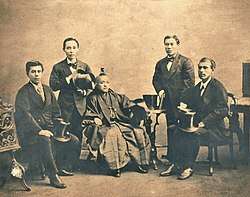
After the Meiji Restoration of 1868, Itō was appointed governor of Hyōgo Prefecture, junior councilor for Foreign Affairs, and sent to the United States in 1870 to study Western currency systems. Returning to Japan in 1871, he established Japan's taxation system. With the advice of Edmund Morel, a chief engineer of the railway department, Ito endeavored to found the Public Works together with Yamao Yozo. Later that year, he was sent on the Iwakura Mission around the world as vice-envoy extraordinary, during which he won the confidence of Ōkubo Toshimichi, one of the leaders of the Meiji government.
In 1873, Itō was made a full councilor, Minister of Public Works, and in 1875 chairman of the first Assembly of Prefectural Governors. He participated in the Osaka Conference of 1875. After Ōkubo's assassination, he took over the post of Home Minister and secured a central position in the Meiji government. In 1881 he urged Ōkuma Shigenobu to resign, leaving himself in unchallenged control.
Itō went to Europe in 1882 to study the constitutions of those countries, spending nearly 18 months away from Japan. While working on a constitution for Japan, he also wrote the first Imperial Household Law and established the Japanese peerage system (kazoku) in 1884.
In 1885, he negotiated the Convention of Tientsin with Li Hongzhang, normalizing Japan's diplomatic relations with Qing-dynasty China. In the same year, In 1885, Itō established a cabinet system of government based on European ideas, replacing the Daijō-kan as the nation's main policy-making organization.
As Prime Minister
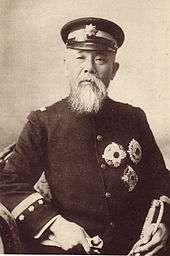
On 22 December 1885, Itō became the first prime minister of Japan. On 30 April 1888, Itō resigned as prime minister, but headed the new Privy Council to maintain power behind-the-scenes. In 1889, he also became the first genrō. The Meiji Constitution was promulgated in February 1889. He had added to it the references to the kokutai or "national polity" as the justification of the emperor's authority through his divine descent and the unbroken line of emperors, and the unique relationship between subject and sovereign.[6] This stemmed from his rejection of some European notions as unfit for Japan, as they stemmed from European constitutional practice and Christianity.[6]
He remained a powerful force while Kuroda Kiyotaka and Yamagata Aritomo, his political nemeses, were prime ministers.
During Itō's second term as prime minister (8 August 1892 – 31 August 1896), he supported the First Sino-Japanese War and negotiated the Treaty of Shimonoseki in March 1895 with his ailing foreign minister Mutsu Munemitsu. In the Anglo-Japanese Treaty of Commerce and Navigation of 1894, he succeeded in removing some of the onerous unequal treaty clauses that had plagued Japanese foreign relations since the start of the Meiji period.
During Itō's third term as prime minister (12 January – 30 June 1898), he encountered problems with party politics. Both the Liberal Party and the Shimpotō opposed his proposed new land taxes, and in retaliation, Itō dissolved the Diet and called for new elections. As a result, both parties merged into the Kenseitō, won a majority of the seats, and forced Itō to resign. This lesson taught Itō the need for a pro-government political party, so he organized the Rikken Seiyūkai (Constitutional Association of Political Friendship) in 1900. Itō's womanizing was a popular theme in editorial cartoons and in parodies by contemporary comedians, and was used by his political enemies in their campaign against him.
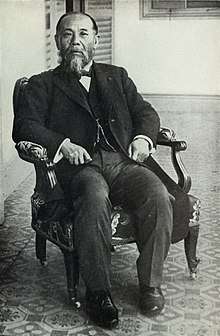
Itō returned to office as prime minister for a fourth term from 19 October 1900, to 10 May 1901, this time facing political opposition from the House of Peers. Weary of political back-stabbing, he resigned in 1901, but remained as head of the Privy Council as the premiership alternated between Saionji Kinmochi and Katsura Tarō.

Toward the end of August 1901, Itō announced his intention of visiting the United States to recuperate. This turned into a long journey in the course of which he visited the major cities of the United States and Europe, setting off from Yokohama on 18 September, traveling through the U.S. to New York City (Itō received an honorary doctorate LL.D. from Yale University in late October[7]), from which he sailed to Boulogne, reaching Paris on 4 November. On 25 November, he reached Saint Petersburg, having been asked by the new prime minister, Katsura Tarō, to sound out the Russians, entirely unofficially, on their intentions in the Far East. Japan hoped to achieve what it called Man-Kan kōkan, the exchange of a free hand for Russia in Manchuria for a free hand for Japan in Korea, but Russia, feeling greatly superior to Japan and unwilling to give up its ability to use Korean ports for its navy, was in no mood to compromise; its foreign minister, Vladimir Lamsdorf, "thought that time was on the side of his country because of the (Trans-Siberian) railway and there was no need to make concessions to the Japanese".[8] Itō left empty-handed for Berlin (where he received honors from Kaiser Wilhelm), Brussels, and London. Meanwhile, Katsura had decided that Man-Kan kōkan was no longer desirable for Japan, which should not renounce activity in Manchuria. When Itō reached London, he had talks with Lord Lansdowne which helped lay the groundwork for the Anglo-Japanese Alliance announced early the following year. The failure of his mission to Russia was "one of the most important events in the run-up to the Russo-Japanese War".[9]
It was during his terms as Prime Minister that he invited Professor George Trumbull Ladd of Yale University to serve as a diplomatic adviser to promote mutual understanding between Japan and the United States. It was because of his series of lectures he delivered in Japan revolutionizing its educational methods, that he was the first foreigner to receive the Second Class honor (conferred by the Meiji Emperor in 1907) and the Third Class honor (conferred by The Meiji Emperor in 1899), Orders of the Rising Sun. He later wrote a book on his personal experiences in Korea and with Resident-General Itō.[10][11][12] When he died, half his ashes were buried in a Buddhist temple in Tokyo and a monument was erected to him.[11][13]
As Resident-General of Korea
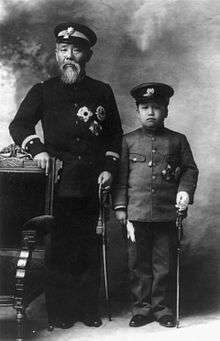
In November 1905, following the Russo-Japanese War, the Japan–Korea Treaty of 1905 was made between the Empire of Japan and the Empire of Korea,[14][15] making Korea a Japanese protectorate. After the treaty had been signed, Itō became the first Resident-General of Korea on 21 December 1905. In 1907, he urged Emperor Gojong to abdicate in favor of his son Sunjong and secured the Japan–Korea Treaty of 1907, giving Japan its authority to control Korea's internal affairs. Itō's position, however, was nuanced. He was firmly against Korea falling into China or Russia's sphere of influence, which would cause a grave threat to Japan's national security. He was initially against radical annexation, advocating instead that Korea should remain as a protectorate. When the cabinet eventually voted for annexing Korea, he insisted and proposed a delay, hoping that the annexation decision could be reversed in the future.[16] His political nemesis came when the politically influential Imperial Japanese Army, led by Yamagata Aritomo, whose main faction was advocating annexation forced Itō to resign on 14 June 1909. However, prior to the cabinet's annexation decision and his resignation on 14 June 1909, Itō had already changed his mind on his original stance of keeping Korea as a "protectorate", approving the annexation of Korea after Katsura Tarō and Komura Jutarō presented Japan's future annexation plans to him on 10 April 1909 (his securing of the Japan–Korea Treaty of 1907 laid the groundwork for a full annexation of Korea, discrediting the claim that Itō was purely in favor of a "protectorate" Korea).[17] His assassination is believed to have accelerated the path to the Japan–Korea Annexation Treaty.[18]
Assassination
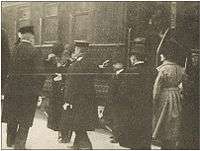

Itō arrived at the Harbin railway station on 26 October 1909 for a meeting with Vladimir Kokovtsov, a Russian representative in Manchuria. There An Jung-geun, a Korean nationalist[18] and independence activist,[19][20] fired six shots, three of which hit Itō in the chest. He died shortly thereafter. His body was returned to Japan on the Imperial Japanese Navy cruiser Akitsushima, and he was accorded a state funeral.[21] An Jung-geun later listed "15 reasons why Itō should be killed" at his trial.[22][23]
Legacy
In Japan
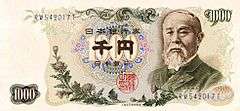
A portrait of Itō Hirobumi was on the obverse of the Series C 1,000 yen note from 1963 until a new series was issued in 1984. Itō's former house in Shinagawa, Tokyo has been transported to the site of his childhood home in Yamaguchi prefecture. It is now preserved as a museum near the Shōin Jinja in Hagi. The publishing company Hakubunkan takes its name from Hakubun, an alternate pronunciation of Itō's given name.
In Korea
The Annals of Sunjong record that Gojong held a positive view of Itō's governorship. In an entry for 28 October 1909, almost three years after being forced to abdicate his throne, the former emperor praised Itō, who had died two days earlier, for his efforts to develop civilization in Korea. However, the integrity of Joseon silloks dated after the Japan–Korea Treaty of 1905 is considered dubious by Korean scholars due to the influence exerted over record-keeping by the Japanese.
Itō has been portrayed several times in Korean cinema. His assassination was the subject of North Korea's An Jung-gun Shoots Ito Hirobumi in 1979 and South Korea's Thomas Ahn Joong Keun in 2004; both films made his assassin An Jung-geun the protagonist. The 1973 South Korean film Femme Fatale: Bae Jeong-ja is a biopic of Itō's adopted Korean daughter Bae Jeong-ja (1870–1950).
Itō argued that if East Asians did not cooperate closely with each other, Japan, Korea and China would all fall victim to Western imperialism. Initially, Gojong and the Joseon government shared this belief and agreed to collaborate with the Japanese military.[24] Korean intellectuals had predicted that the victor of the Russo-Japanese War would assume hegemony over their peninsula, and as an Asian power, Japan enjoyed greater public support in Korea than did Russia. However, policies such as land confiscation and the drafting of forced labor turned popular opinion against the Japanese, a trend exacerbated by the arrest or execution of those who resisted.[24] Ironically, An Jung-geun was also a proponent of what would later come to be called Pan-Asianism. He believed in a union of the three East Asian nations in order to repel the "White Peril"[18] of Western imperialism and restore peace in the region.
Genealogy
- Hayashi family
∴Hayashi Awajinokami Michioki ┃ ┣━━━━━━━┳━━━━━━━┳━━━━━━━━━━━━━━━━┳━━━━━━━━┳━━━━━━━━━┳━━━━━━━┳━━━━━━━━┓ ┃ ┃ ┃Hayasi Magoemon ┃ ┃ ┃ ┃ ┃ Michimoto Michiyo Michisige Michiyoshi Michisada Michikata Michinaga Michisue ┃ ┃ ┃Hayasi Magosaburō Nobukatsu ┃ ┃ ┃Hayasi Magoemon Nobuyoshi ┃ ┏━━━━━━━━━━━━━━━━╋━━━━━━━━━┳━━━━━━━┓ ┃Hayasi Magoemon ┃ ┃ ┃ Nobuaki Sakuzaemon Sojyurō Matazaemon ┃ ┃ ┃ ┃ ┃Hayasi Hanroku ┃ Nobuhisa Genzō ┃ ┃ ┣━━━━━━━━━┓ ┃ ┃ ┃ ┃ Sōzaemon Heijihyōe Yoichiemon ┃ ┃ ┏━━━━━━━━━┻━━━━━━┓ ┏━━━━━┫ ┃Hayasi Hanroku ┃ ┃ ┃ Rihachirō Riemon Masuzō Sukezaemon ┃adopted son of Hayasi Rihachirō ┏━━━━┳━━━━━━━━━━━━━━━━━━━━━━┫ ┃Itō ┃Hayasi Shinbei's wife ┃Morita Naoyoshi's wife Jyuzō woman woman ┃ ┃ ┃'''Itō Hirobumi''' ┃ ┏━━━━━━━╋━━━━━━━━┳━━━━━━━┳━━━━━┓ ┃Itō ┃Kida ┃Itō ┃ ┃ Hirokuni Humiyoshi Shinichi woman woman ┃ ┣━━━━━━━┳━━━━━━━━━┳━━━━━━━━━━┳━━━━━━┳━━━━━━━┳━━━━━━━━┳━━━━━━━┳━━━━━━━━━┳━━━━━━━━┳━━━━━━━━━┳━━━━━┳━━━┓ ┃Itō ┃Shimizu ┃Itō ┃Itō ┃Itō ┃Itō ┃Itō ┃Itō ┃Itō ┃Itō ┃ ┃ ┃ Hirotada Hiroharu Hiromichi Hiroya Hirotada Hiroomi Hironori Hirotsune Hirotaka Hirohide woman woman woman ┃ ┣━━━━━━━┳━━━━━┳━━━━┳━━━━━┳━━━┓ ┃Itō ┃ ┃ ┃ ┃ ┃ Hiromasa woman woman woman woman woman ┃ ┣━━━━━━━┓ ┃Itō ┃ Tomoaki woman
- Itō family
∴ Itō Yaemon ┃ Itō Naoemon (Mizui Buhei)Yaemon's adopted son ┃ Itō Jyuzō (Hayashi Jyuzo)Naoemon's adopted son ┃ Itō Hirobumi (Hayashi Risuke)
Honours
From the Japanese Wikipedia article
Japanese
Peerages
- Count (7 July 1884)
- Marquis (5 August 1895)
- Prince (21 September 1907)
Decorations




Court ranks
- Fifth rank, junior grade (1868)
- Fifth rank (1869)
- Fourth rank (1870)
- Senior fourth rank (18 February. 1874)
- Third rank (27 December 1884)
- Second rank (19 October 1886)
- Senior second rank (20 December 1895)
- Junior First Rank (26 October 1909; posthumous)
Foreign
.svg.png)
.svg.png)
.svg.png)
.svg.png)


.svg.png)

.svg.png)



_crowned.svg.png)
Popular culture
- Portrayed by Hisaya Morishige in 1980 Japanese movie The Battle of Port Arthur.
- Portrayed by Yoon Joo-sang in the 2001-2002 KBS TV series Empress Myeongseong.
- Portrayed by Gō Katō in the 2009-2011 NHK TV series Saka no Ue no Kumo.
- Portrayed by Hiroyuki Onoue in the 2010 NHK TV series Ryōmaden.
- Portrayed by Hitori Gekidan in the 2015 NHK TV series Hana Moyu.
- Portrayed by Kenta Hamano in the 2018 NHK TV series Segodon.
- Portrayed by Kim In-woo in the 2018 tvN and Netflix TV series Mr. Sunshine.
See also
- Japanese students in Britain
References
- "Famous Alumni". UCL.
- Craig, Albert M. (14 July 2014) [1st pub. 1986]. "Chapter 2: The Central Government". In Jansen, Marius B.; Rozman, Gilbert (eds.). Japan in Transition: From Tokugawa to Meiji. Princeton University Press. pp. 60–61. ISBN 978-0691604848.
- "Ahn Jung-geun Regarded as Hero in China". The Korean Times. Archived from the original on 15 August 2018. Retrieved 15 August 2018.
- Dudden, Alexis (2005). Japan's Colonization of Korea: Discourse and Power. University of Hawaii Press. ISBN 0-8248-2829-1.
- Takii, Kazuhiro (2014). Itō Hirobumi - Japan's First Prime Minister and Father of the Meiji Constitution. trans. Takeshi Manabu. Routledge. ISBN 978-0415838863.
- W. G. Beasley,The Rise of Modern Japan, pp. 79–80 ISBN 0-312-04077-6
- "United States". The Times (36594). London. 24 October 1901. p. 3.
- Ian Nish, The Origins of the Russo-Japanese War (Longman, 1985; ISBN 0582491142), p. 118.
- Nish, The Origins of the Russo-Japanese War, p. 116.
- Topics of the Week: "George Trumbull Ladd", The New York Times. 22 February 1908.
- "Business: Japanese Strip", Time. 8 May 1939.
- "American Honored by the Japanese", The New York Times. 22 October 1899.
- "Great Head Temple Sôjiji". 2007. Retrieved 29 July 2009.
- 이토 히로부미는 직접~ :한계옥 (1998년 4월 10일). 〈무력을 앞장 세워 병탄으로〉, 《망언의 뿌리를 찾아서》, 조양욱, 1판 1쇄, 서울: (주)자유포럼, 97~106쪽쪽. ISBN 89-87811-05-0
- Lee Hang-bok."The King's Letter," English JoongAng Daily. 22 September 2009.
- Umino, Fukuju (2004). Hirobumi Ito and Korean Annexation (Ito hirobumi to kankoku heigou) (in Japanese). Aoki Shoten. ISBN 978-4-250-20414-2.
- Ogawara, Hiroyuki (2010). 伊藤博文の韓国併合構想と朝鮮社会 (in Japanese). 岩波書店. ISBN 978-4000221795.
- Keene, Donald (2002). Emperor of Japan: Meiji and His World, 1852–1912. Columbia University Press. pp. 662–667. ISBN 0-231-12340-X.
- "What Defines a Hero?". Japan Society. Archived from the original on 4 October 2007. Retrieved 29 January 2008.
- An, Jung-geun, Naver encyclopedia
- Nakamura, Kaju (2010) [1910]. Prince Ito – The Man and Statesman – A Brief History of His Life. Lulu Press (reprint). ISBN 978-1445571423.
- "The Harbin Tragedy". The Straits Times. 2 December 1909. Retrieved 3 July 2017.
- "Why Did Ahn Jung-geun Kill Hirobumi Ito?". The Korea Times. 24 August 2009.
- Lee Jeong-sik (이정식) (May 2001). 긴급대특집, 일본 역사교과서 왜곡파문 [Special report on Japan's history textbook issue.]. New DongA (in Korean). Retrieved 1 May 2012.
... initially many Koreans supported Japanese against Russians, and helped Japanese military. ... Many intellectuals had predicted that whoever wins the Russo-Japanese War, Joseon would be controlled by a victor. Still, they had hoped for the Asian power's victory. .... On 14 April 1904, Japan demanded unrestricted fishing rights all across Korean peninsular. On 28 June, Japan asked for the right to use every unclaimed land in Korea. Many Japanese gangsters had beaten Korean citizens in numerous occasions. ... 1904, U.S. diplomatic cable by Horace Allen, then U.S. representative in Korea. [...러·일전쟁 때 많은 조선인이 일본측에 동조했고, 일본군을 도왔다... 많은 지식인이 전쟁이 끝난 후에 조선은 승자에게 굴(屈)하고 주권을 상실할 것이라 예측했음에도, 러시아보다는 ‘동족(同族)’인 일본이 승리하기를 바랐다. ... (1) 1904년 4월14일. 일본은 조선반도 전역에서 거의 무제한적인 어업권을 요구했다. (2) 6월28일. 그들은 지금 조선 내 모든 황무지를 점거하고 사용할 수 있는 권리를 요구했다. (3) 많은 수의 일본인 불량배 노동자들이 조선 사람들을 괴롭히고 있다. ...1904년 주한미국공사 호레스 앨런의 보고서]
- "Latest intelligence – Germany". The Times (36639). London. 16 December 1901. p. 6.
- "Latest intelligence – Russia and Japan". The Times (36626). London. 30 November 1901. p. 7.
- "No. 27397". The London Gazette. 14 January 1902. p. 295.
- "Court circular". The Times (36667). London. 17 January 1902. p. 8.
Sources
- Nish, Ian. (1998) The Iwakura Mission to America and Europe: A New Assessment. Richmond, Surrey: Japan Library. ISBN 9781873410844; ISBN 0415471796; OCLC 40410662
Further reading
- Edward, I. "Japan's Decision to Annex Taiwan: A Study of Itō-Mutsu Diplomacy, 1894–95." Journal of Asian Studies 37#1 (1977): 61–72.
- Hamada Kengi (1936). Prince Ito. Tokyo: Sanseido Co.
- Johnston, John T.M. (1917). World patriots. New York: World Patriots Co.
- Kusunoki Sei'ichirō (1991). Nihon shi omoshiro suiri: Nazo no satsujin jiken wo oe. Tokyo: Futami bunko.
- Ladd, George T. (1908). In Korea with Marquis Ito
- Nakamura Kaju (1910). Prince Ito, the man and the statesman, a brief history of his life. New York: Japanese-American commercial weekly and Anraku Pub. Co.
- Palmer, Frederick (1910). Marquis Ito: the great man of Japan. n.p.
External links
| Wikimedia Commons has media related to Itō Hirobumi. |
- Works by or about Itō Hirobumi at Internet Archive
- About Japan: A Teacher's Resource Ideas about how to teach about Ito Hirobumi in a K-12 classroom
- . Encyclopædia Britannica (11th ed.). 1911.
- Newspaper clippings about Itō Hirobumi in the 20th Century Press Archives of the ZBW